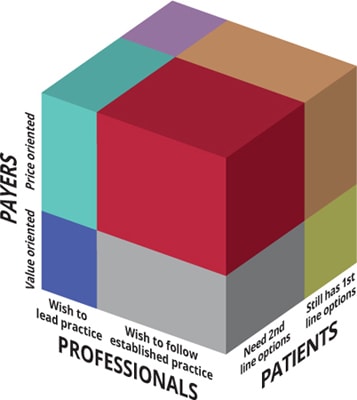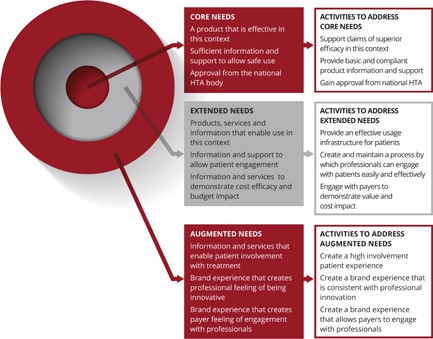You bear the marks of your evolutionary environment. You walk upright and talk because these traits provided your ancestors with a competitive advantage in the African savannah. The same is true of the life science industry. Many of its traits are the result of adaptation to a world of freely prescribing doctors and blockbuster drugs. The most salient example of this is the way we design brand strategies, which is often better suited to the 20th century than the 21st, much as my Neolithic love of sugar and fat is a hindrance, rather than helpful, in today’s world.
The maladaptation of brand strategy is most obvious in those markets where followers and me-toos make differentiation difficult. In such markets, the traditional, molecule-centred formulation of brand strategy (indication plus claims) is now no longer sufficient to create customer preference. If you need evidence of this, consider how few launches achieve their goals, the frequent rejection of new products by HTAs or the increasing price pressure faced by even successful brands.
But evolution never sleeps and, in the practices of our most advanced firms, we see the emergence of a new way to design brand strategy. Still built on the molecule of course, but now extended to include activity beyond the indication and value beyond the claims. Necessarily, this evolution is an idiosyncratic complex process with each successful brand finding success in its own way. My research sets out to find the generalisable lessons from which other firms can learn.
New foundations of value
For earlier generations of brand managers, strategy began with the product. Today, it begins with a customer-centric definition of the market, which doesn’t mention the product at all. Instead, the market is described through the customers’ eyes as a fundamental need to be met, the patients, professionals and payers involved and the motivations that drive their preference. This way of looking at the market is uncomfortable to those steeped in thinking of the market as a product category or a disease type, but it allows a much clearer definition of what the brand strategy actually is.
In many of the brand plans I examine, the brand strategy is implied but not stated explicitly. Often, strategy is substituted for by an impenetrable mass of tactics and budgets. By contrast, more evolved brand plans recognise that strategy is a synonym for a choice. Good plans explicitly state which market segments they will not fight for, which they will aim to dominate and, importantly, how they will create customer-perceived value for those targeted customers. In my work, I call this explicit format of strategy statement ‘Drucker’s Definition’, after the great guru who identified its importance back in the 1950s. Such an explication of brand strategy might seem obvious to you but challenge yourself with this test. If I picked up your brand plan today, could I see which parts of the market you are not fighting for? And could I see how your value proposition compels your targeted customers to choose your brand? In many cases, the brand plans I see don’t answer those critical questions. Together, a customer-centric market definition and brand strategy as stated in Drucker’s terms are the foundations of brand differentiation.
From strategy to value
Defining your market and brand strategy is the beginning of a brand that creates value beyond its indication and claims but there is much more to be observed in those companies that successfully compete in mature markets. In particular, the process by which effective firms translate their ‘Drucker’s Definition’ brand strategy into an activity plan is very different from those firms still stuck in the 20th century. The default approach for most firms is to cut and paste a set of activities from last year and spruce it up with some new tactics. Currently, for example, neophiliac brand managers love anything vaguely digital. Before that, closed loop marketing was the buzz phrase. I am old enough to remember when direct mail was going to change the world. While these tactics have some value, their application is often incoherent and owes more to fashion than strategic thinking.
By contrast, what I see evolving is a method of translating strategy into action that has three distinct phases and results in an activity programme that is both consistent with the strategy and creates compelling value in the eyes of the customer. Like an evolved metabolic pathway, each of the three stages is connected to the others and is essential for a viable brand strategy.
Value in context
 To our marketing ancestors, target segments were categories of either patients or prescribers. Patients with contraindications or high-prescribing doctors were typical targets. But this was an evolutionary adaptation to a period when products were clearly differentiated, doctors made decisions and patients did as they were told. None of those three conditions is universally true in today’s market, where generics abound, payers direct and patients have Google-fuelled opinions. And yet this evolutionary relic of segmentation and targeting persists long after it has become problematic, much like my love of sugar and fat.
To our marketing ancestors, target segments were categories of either patients or prescribers. Patients with contraindications or high-prescribing doctors were typical targets. But this was an evolutionary adaptation to a period when products were clearly differentiated, doctors made decisions and patients did as they were told. None of those three conditions is universally true in today’s market, where generics abound, payers direct and patients have Google-fuelled opinions. And yet this evolutionary relic of segmentation and targeting persists long after it has become problematic, much like my love of sugar and fat.
At the root of today’s strongly differentiated brands lies a target context, not an individual. For example, a company might define one of its targets as the usage context in which the prescriber is payer-compliant, the payer is risk-averse and the patient is indolent. Of course, such contextual segments are small so firms tend to target multiple different contexts with multiple, different value propositions. Contextual segmentation is the starting point for effective brand strategy. It is beyond the scope of this article to explain it fully, but it has been covered in a previous PME article “Superior Segmentation” and an example is shown in figure 1.
Needs-driven value
The raison d’être of a brand strategy is to create preference of the contextual segment for the brand over its competitors. Traditional, product-oriented marketers attempt this by various forms of product-push: education to raise salience of clinical issues, followed by detailing of product features that address those issues. In recent years, the language and techniques used to do this have grown more complicated but this product-oriented approach remains dominant in the industry. Like segmentation and targeting, it is an evolutionary hangover from a market environment that no longer exists in many therapy areas.
 In a leading minority of companies, we see an inversion of this approach in which the needs of the customer, rather than the features of the product, drive activity. Through insight into the thinking of the contextual segment, effective firms identify the core, extended and augmented needs of those patients, payers and professionals, as shown in figure 2. Importantly, the needs of each contextual segment differ, particularly at the extended and augmented level. Indeed, differing needs between segments and shared needs within segments are what differentiate this approach from traditional categorisation of customers. It is these segment-specific needs that drive the third stage of the process.
In a leading minority of companies, we see an inversion of this approach in which the needs of the customer, rather than the features of the product, drive activity. Through insight into the thinking of the contextual segment, effective firms identify the core, extended and augmented needs of those patients, payers and professionals, as shown in figure 2. Importantly, the needs of each contextual segment differ, particularly at the extended and augmented level. Indeed, differing needs between segments and shared needs within segments are what differentiate this approach from traditional categorisation of customers. It is these segment-specific needs that drive the third stage of the process.
Value creating activity
One aspect of brand strategy that has not changed in decades is the plethora of choice for brand managers. An entire industry of support agencies has evolved to give them ever more creative and expensive ways to allocate their limited resources. As a result, the process by which brand teams decide what to do is often more random than they like to admit. A slick agency presentation is sometimes more likely to influence choice than a rational evaluation of which activities are most likely to create customer preference.
Following the identification of core, extended and augmented needs of a contextual target segment, the third way that practice is evolving is that activity is driven by those customer needs, not by the availability of novel tactics. When the needs of the contextual segment are comprehensively catalogued, they provide a clear direction for what the brand leader should spend her budget on and, just as importantly, which fashions she should resist. A simplified example of this is shown in figure 2. Importantly, derivation of the activity plan from a single source – the needs of the contextual segment – also leads to a programme that meets the essential criteria for effectiveness: it is consistent with strategy, it is complete and it is internally coherent.
Evolved value
There is ample evidence that approaches to brand strategy that evolved in the post-war world are both still in use and increasingly ineffective. Just as my passion for chocolate is a maladaptation to the 21st century, the life science industry has its own evolutionary hangovers. Foremost among these are the embedded organisational routines for detailing the indication and claims of a product, which belong in a time when doctors prescribed, patients obeyed and payers paid.
The pressures of the 21st century market are slowly driving the adaptation of brand strategy. Its principal mutations are a customer-centric market definition, Drucker’s explication of strategic choices and, critically, activity programmes derived from the multi-level needs of the targeted contextual segment. As with biological evolution, this is a tortuous process that will see the survival of few brands and the extinction of many. Unlike biological evolution, brand leaders have the opportunity to observe and copy the adaptation of others.
This article is based on Professor Smith’s new book “Brand Therapy: 15 Techniques for Creating Brand Strategy in Pharma and Medtech”, which is available from Amazon.




